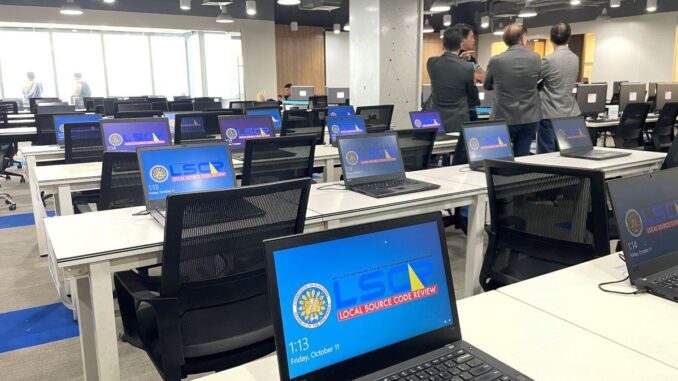
The Commission on Elections (Comelec) is set to begin on Monday, October 14, the review of the local source codes to be used for the automated election system (AES) in the May 2025 polls.
Speaking to reporters on Friday, Comelec spokesperson Rex Laudiangco said the review—which will run until the last week of December—includes the source codes for the Full Automation System with Transparency Audit/Count (FASTrAC) and Online Voting and Counting System (OVCS) for overseas voters.
“Ang source codes ang mga commands na nagpapaandar sa mga programa at tina-translate sa mga machines para magawa nila ang mga functionality na hinihingi natin sa mga makina,” said Laudiangco.
(Source codes are commands that drive the programs and get translated into machine language so the machines can perform the functions we ask from them.)
“Ganun kaimportante na mareview nang bawat isa kasama na diyan ang malwares at kung may makikita pa na para sa improvements ng ating sistema,” he said.
(The reviews are crucial, and they need to include malware detection and any findings that can help improve our system.)
The poll body conducted a walkthrough of the venue of the local source code review (LSCR) in Makati City, where 100 computer terminals were set up.
Apart from the source codes, the poll body providers also added review tools in the terminals to help the reviewers, which include IT experts and members of the Parish Pastoral Council for Responsible Voting and the National Citizens’ Movement for Free Elections, among others.
“Vulnerability testing. ‘Yan ‘yung kasama sa gagawin nila. Titingnan nila ano ‘yung susceptibility, ‘yung vulnerabilities ng sistema. Titingnan din nila kung may malicious codes, kung may mali, and at the same time, titingnan nila kung ‘yung functionality na gusto mangyari ng Comelec…nandun ba sa codes at tama bang mai-implement at execute ‘yan,” said Laudiangco.
(Part of their duties is vulnerability testing. They will examine the system’s susceptibility and vulnerabilities. They will also look for malicious codes and mistakes, and at the same time, they will check if the intended functionality of Comelec is present in the codes and correctly implemented and executable.)
“‘Yung source code, code siya na readable…Pinapakita niyan kung ano ang gagawin at i-execute ng makina,” he added.
(The source code is a readable code…It shows what the machine will do and execute.)
The notes and observations from the LSCR will be submitted to the contracted international certifying body for certification, according to the Comelec.
“Ang output ng lahat ng review ay para sa final trusted build ng sistema…Ang final trusted build, ‘yan na ‘yung ipapasok sa mga sistema — to the ACMs (automated counting machines), CCS (consolidation and canvassing system), ‘yan ‘yung programang papaganahin natin,” said Laudiangco.
(The outcome of all reviews is for the final trusted build of the system…The final trusted build—that’s what we will load into the systems — to the ACMs, CCS—that’s the program we will be executing.)
The final trusted build will then be deposited in the vault of the Bangko Sentral ng Pilipinas (BSP), which may only be accessed if ordered by a court.
“Ang purpose bakit dine-deposit siya sa BSP, in case magkaroon ng question at problema. Ina-audit natin, diba? Sa paga-audit na ‘yan pwede natin ikumpara sa final trusted build para ipakita sa lahat na kung ano ang pinagkatapusan natin ‘yun ang ginamit at walang pagbabago sa sistema,” he added.
(The purpose of depositing it at the BSP is in case there are questions and problems. We are auditing it, right? During the audit, we can compare it with the final trusted build to show everyone what we have achieved and that there has been no change in the system.)
Hardware test
Meanwhile, Laudiangco said the poll body may finish the hardware acceptance test (HAT) of all 110,000 ACMs for Eleksyon 2025 before the end of the month.
“Tuloy-tuloy ang ating laboratory test at HAT. Ine-expect namin na ang 110,000 ay matapos na ng October,” he added.
(The laboratory tests and HAT tests are ongoing. We are expecting to conclude the HAT for the 110,000 ACMs by October.)
Latest data from Comelec showed a total of 63,480 ACMs had arrived in the country as of September 11. South Korean firm Miru Systems Inc. had said it was targeting to finish the delivery of the 110,000 ACMs by November. —VBL, GMA Integrated News





Be the first to comment